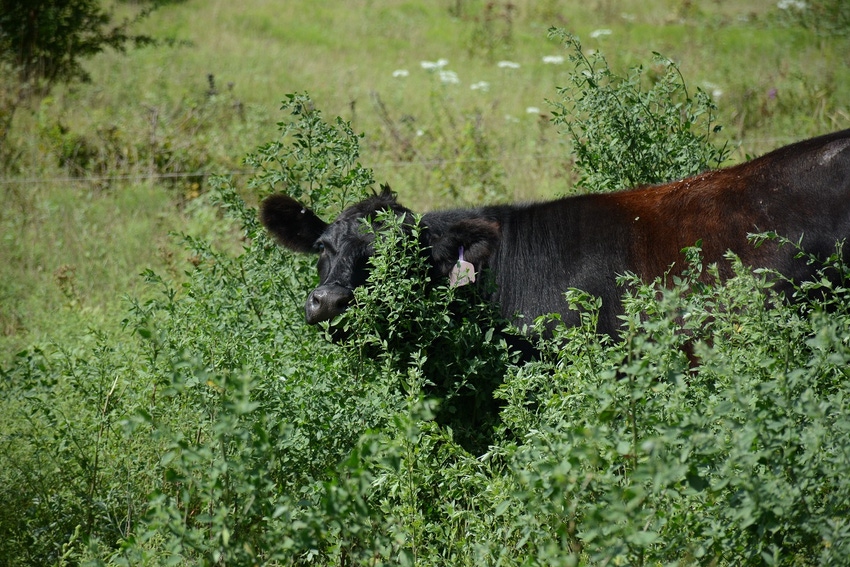
Maybe I don't have a good enough memory to totally recollect how I got interested in animal health. But at some point it became my focus, and being of the male gender I don’t have gifts for much multi-tasking. I’ve been focused on health for a long time.
Billions are now spent (mostly wasted) annually in the US on pasture weed control and yet we know for a fact that they are or should be our allies.
Recently I read this list of five plants is presently considered to be the worst weeds in much of the US.
Palmer amaranth
Morning glory
Lamb’s quarter
Waterhemp
Horseweed
Giant ragweed also was mentioned as a growing threat.
Since our cattle, soil and wildlife appreciate (actually love) these plants for a least several months almost every year I must have been reading a row-crop guy’s analysis. He left out eastern red cedar, cocklebur, sagebrush, thorn brush and trees, buckbrush, blackberry, mesquite, lanceleaf ragweed, and quite a few others.
Most anywhere you go there are more than several plants that people hate. With zero exceptions there is a reason for their presence and if they are increasing it indicates a management error.
The row-crop boys made a big mistake back in the early 1970s when they tore out their fences and took the livestock out of their programs. With the huge market swings of the past decade, the new electric fence technology and cattle handling knowledge, I don’t completely understand why their lights are not coming on.
But the truth is that the vast majority of cattle guys are still declaring wars on the plants that our management is propagating. An example is eastern red cedar, the number one weed in much of the Great Plains. Cedar and several other woody species (brush) quickly come into overgrazed pastures that are set stocked at low cattle densities.
“Reduce cattle numbers and spread the cattle out” has been the most common “expert” recommendation for better than a hundred years. I don’t know how to say it nicely, so I'll say it bluntly: This has been bad advice with bad outcomes for a long time.
Conservation Reserve Program (CRP) ground is another example. Land coming out of crops quickly goes to forbs and legumes, followed by grass, bushes, brush and trees. This is typical but not normal because there are zero cattle, or perhaps I should state there are very few cattle being properly managed. When drought comes and the CRP ground is released for grazing and grazed in ultra-high densities wonderful things happen both on top and underground. The “bust” is a requirement of the “boom” and weeds are a requirement of health renewal of all systems (soil, plant and animal). Note that as soil health returns the forbs, also known as weeds, become more palatable for longer periods and later become decreasers.
This spring our cattle quickly shed off winter hair due to their high intake of tap-rooted forbs. Wet weather and several too many cattle had led to an overage of winter trampling and more mud than we normally like. But the broadleaf “weeds” got our steers to going forward in mid-March and we started growing seasonal gains and health 70 days in front of our neighbors, who were spending $10 to $20 per acre on weed control while continuing to feed hay. Our hay feeding stopped March 28, even though we were overstocked all fall and winter.
A handful of ranchers and land managers have caught onto the natural model and the importance of cattle grazed in high densities for short periods of time followed by cattle removal and complete plant recovery. Remember that the grass normally follows the soil amendments brought on by the forbs and legumes. As the grass gains height and deeper roots and closer plant spacing with more species diversity, the forbs decrease in function and number.
I question the reality of a “worst weeds” list. I am not even sure there such a thing as weeds. But I will agree that there are years when we might not need as many bird nests. You see, birds are our major pasture cleanser, with the aid of sunlight. Forbs, brush and trees are nesting sites. This is really important for animal health.
Here are five points to remember concerning weedy plants and their control and use:
Chaos, don’t graze a pasture the same time or same way every year. Remember to employ different months, different starting and ending points, different amounts of time, but always with high stock densities.
Train cattle to eat and enjoy weeds by adding calcium to the soil to sweeten the plants; spray them with saltwater; run calves and yearlings with weed-trained older cattle; graze in very high stock densities for very short periods
Do not mow large areas for weed control.
Use chemical control sparingly, very sparingly. An occasional spot is plenty.
Use fire about every 10 to 20 years if necessary in certain situations. If you are really good with fire then you are burning too often.
The final truth is that weeds are a plus in most instances with good management. There are exceptions but they are rare, really rare.
Understanding leads to less hate and improved health on our part, too. Without exception weeds are an indicator of soil and grazing conditions and often result from our mistakes. Knowledge and grazing execution can replace chemicals and clipping. Health and profit are the stake. Real forb knowledge and utilization can become another of our unfair advantages.
About the Author(s)
You May Also Like






